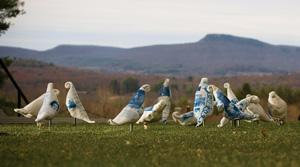By Katherine Duke '05
 Birds in the Park, which had a one-day showing near the War Memorial (after appearing in the National Mall in Washington, D.C.), originated in the lead-up to the U.S. invasion of Iraq, when artist Christy Hengst '89 made silk screens of newspaper articles about the war. |
Those walking across the First-Year Quad near the War Memorial on March 26 noticed some unusual visitors to campus: 30 white porcelain bird sculptures arranged on the ground and railings. By 7 a.m. that Friday, artist Christy Hengst ’89 had arrived on the Quad, birds in tow, to set up her traveling installation Birds in the Park, which had come to Amherst for a one-day showing.
Birds in the Park originated in the weeks leading up to the U.S. invasion of Iraq, when Hengst found herself “obsessively saving” and making silk screens of newspaper articles about the war; then she began layering these with poetry, love letters and pictures of her two children. The sculptures’ shapes grew out of Hengst’s experiments with silk screening onto wet clay tiles and then bending the tiles. She fired texts and images onto each figure in cobalt blue. The birds “are, in a sense, carrier pigeons,” she explains. “The message they bear is an exploration of the beautiful and the horrible side by side.”
Hengst majored in fine arts at Amherst and painted a series of 4-foot-by-8-foot panels that were on display for many years in Merrill Science Center. After devoting years to large, collaborative outdoor projects, Hengst, who is based in Santa Fe, N.M., switched her focus to smaller work for galleries and museums. She considers Birds in the Park her re-entry into public art. “I started to realize that I’d really love to see these pieces outside,” she says.
The birds began appearing last spring around parks, libraries and cafes in Santa Fe. People would “see them pop up in one place on one day and disappear,” Hengst says, “and then, some days later, show up in another place.” Soon, the birds ventured farther: to New Orleans, California beaches, New York City’s Central Park and Washington, D.C. They’ve even flown to France, Germany and the Galápagos Islands of Ecuador, sparking the curiosity of passersby.
In a lecture she gave on campus the day before the installation, Hengst showed slides of the sculptures in various locales. She spoke of the challenges of transporting them safely—in laundry baskets, backpacks and suitcases—and of jumping through bureaucratic hoops for permission to set them up at certain sites.
The flock now numbers about 100 unique pieces. In addition to using public texts and her own photography, Hengst has been collaborating with writer and Vietnam War veteran Tim Origer, English poet Henry Shukman, photographer Maria De Las Casas and her father, Werner Hengst, to create some of the material that appears on the birds. She’s now planning a “landing” in Peenemünde, Germany, where her grandfather helped develop V-1 and V-2 rockets during World War II.
“When you make art that goes into a specific place, even if it’s only for a day,” Hengst says, “you form a relationship with that place.” By early evening of that cold, bright Friday in March, the birds had “flown away” from the college’s campus, to continue their international migrations.
Photo by Samuel Masinter '04